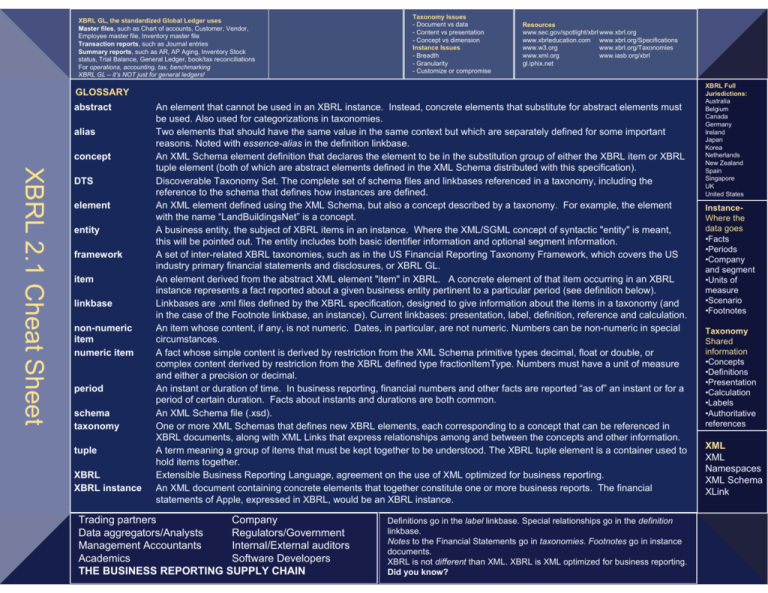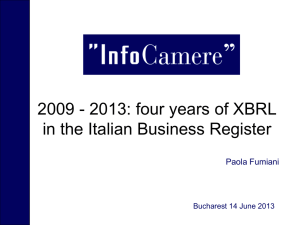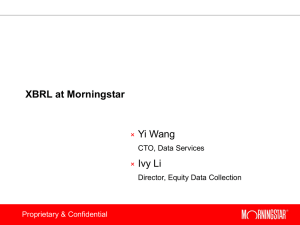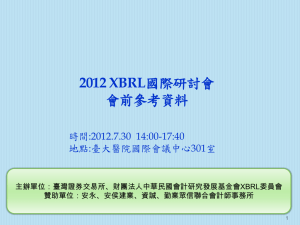XBRL 2.1 Cheat Sheet
advertisement

XBRL GL, the standardized Global Ledger uses Master files, such as Chart of accounts, Customer, Vendor, Employee master file, Inventory master file Transaction reports, such as Journal entries Summary reports, such as AR, AP Aging, Inventory Stock status, Trial Balance, General Ledger, book/tax reconciliations For operations, accounting, tax, benchmarking XBRL GL – it’s NOT just for general ledgers! Taxonomy Issues - Document vs data - Content vs presentation - Concept vs dimension Instance Issues - Breadth - Granularity - Customize or compromise Resources www.sec.gov/spotlight/xbrl www.xbrl.org www.xbrleducation.com www.xbrl.org/Specifications www.w3.org www.xbrl.org/Taxonomies www.xml.org www.iasb.org/xbrl gl.iphix.net GLOSSARY abstract alias concept XBRL 2.1 Cheat Sheet DTS element entity framework item linkbase non-numeric item numeric item period schema taxonomy tuple XBRL XBRL instance An element that cannot be used in an XBRL instance. Instead, concrete elements that substitute for abstract elements must be used. Also used for categorizations in taxonomies. Two elements that should have the same value in the same context but which are separately defined for some important reasons. Noted with essence-alias in the definition linkbase. An XML Schema element definition that declares the element to be in the substitution group of either the XBRL item or XBRL tuple element (both of which are abstract elements defined in the XML Schema distributed with this specification). Discoverable Taxonomy Set. The complete set of schema files and linkbases referenced in a taxonomy, including the reference to the schema that defines how instances are defined. An XML element defined using the XML Schema, but also a concept described by a taxonomy. For example, the element with the name “LandBuildingsNet” is a concept. A business entity, the subject of XBRL items in an instance. Where the XML/SGML concept of syntactic "entity" is meant, this will be pointed out. The entity includes both basic identifier information and optional segment information. A set of inter-related XBRL taxonomies, such as in the US Financial Reporting Taxonomy Framework, which covers the US industry primary financial statements and disclosures, or XBRL GL. An element derived from the abstract XML element "item" in XBRL. A concrete element of that item occurring in an XBRL instance represents a fact reported about a given business entity pertinent to a particular period (see definition below). Linkbases are .xml files defined by the XBRL specification, designed to give information about the items in a taxonomy (and in the case of the Footnote linkbase, an instance). Current linkbases: presentation, label, definition, reference and calculation. An item whose content, if any, is not numeric. Dates, in particular, are not numeric. Numbers can be non-numeric in special circumstances. A fact whose simple content is derived by restriction from the XML Schema primitive types decimal, float or double, or complex content derived by restriction from the XBRL defined type fractionItemType. Numbers must have a unit of measure and either a precision or decimal. An instant or duration of time. In business reporting, financial numbers and other facts are reported “as of” an instant or for a period of certain duration. Facts about instants and durations are both common. An XML Schema file (.xsd). One or more XML Schemas that defines new XBRL elements, each corresponding to a concept that can be referenced in XBRL documents, along with XML Links that express relationships among and between the concepts and other information. A term meaning a group of items that must be kept together to be understood. The XBRL tuple element is a container used to hold items together. Extensible Business Reporting Language, agreement on the use of XML optimized for business reporting. An XML document containing concrete elements that together constitute one or more business reports. The financial statements of Apple, expressed in XBRL, would be an XBRL instance. Trading partners Company Data aggregators/Analysts Regulators/Government Management Accountants Internal/External auditors Academics Software Developers THE BUSINESS REPORTING SUPPLY CHAIN Definitions go in the label linkbase. Special relationships go in the definition linkbase. Notes to the Financial Statements go in taxonomies. Footnotes go in instance documents. XBRL is not different than XML. XBRL is XML optimized for business reporting. Did you know? XBRL Full Jurisdictions: Australia Belgium Canada Germany Ireland Japan Korea Netherlands New Zealand Spain Singapore UK United States InstanceWhere the data goes •Facts •Periods •Company and segment •Units of measure •Scenario •Footnotes Taxonomy Shared information •Concepts •Definitions •Presentation •Calculation •Labels •Authoritative references XML XML Namespaces XML Schema XLink Keeping up on XBRL Meetings •Upcoming events: •http://www.xbrl.org/UpcomingEvents/ •Past events: (Find slides to learn!) •http://www.xbrl.org/UpcomingEvents/ What are Dimensional Taxonomies? Dimensions 1.0 is a modular, optional extension to the XBRL 2.1 Specification allowing XBRL taxonomy authors to define and restrict dimensional information for instance authors. A typical example of a dimension is a class of sales and the breakdown of that class of sales by product or by region. Dimensional taxonomies are used to communicate appropriate values and validate the content included in the segment and/or scenario of an instance document. INSTANCE DOCUMENTS id context unit An internal pointer, an XML valid name, used for contexts, units of measure Holds the entity, period and scenario information A single unit of measure or a compound (unit1 x unit2 or unit1 / unit 2). If monetary, should refer to iso4127 standard currencies. Otherwise, no standard values entity The identifier of the organization being reported upon, with an identifier (such as the stock ticker) and a schema (such as the exchange web site) and optional segments. Segments can be validated against Dimensional taxonomies. A point in time date in ISO8601 format, or two dates representing the beginning and end dates for the period Text associated with a fact expressed in an instance. Must be differentiated from Notes to the Financial Statements. Actual, Budget, Forecast or any other. No standard values. Can be validated with Dimensional taxonomies. period footnote scenario TAXONOMIES Unique name for computer, XML valid; often based on primary label Unique identifier, based on element name Human readable descriptions and definitions; unique for human reading and comprehension. Advanced rules for validating the content of instances or creating new instances from existing instances. Professional or other guidance that drives definition, presentation, calculation, formulas Order among siblings and association with presentation parent(s) Adds or subtracts from siblings when being added to validate parent(s) (also other arithmetic functions) Other relationships. Important to identify different concepts that should have the same value within the same context using essence-alias, show items dependent on others with requires-element, or inheritance with general-special. data type General numbers are decimal; text or other freeform are string; numbers representing shares of stock are shares; numbers representing currency are monetary; a web site is URI; dates or times are dateTime; others Tuples have no content but must contain other tuples or items. Items have content or act as categories if abstract. Special uses of substitution group allow inheritance of some attribute of an original. Element will not appear in the instance, but used for categorization, reuse; has children, labels, other information Normally a debit (would appear with parenthesis as a default if a credit), normally a credit (would appear with parenthesis as a default if a debit) or otherwise periodType of I”instant” if point in time (like Balance Sheet items), “duration” if period of time (like Income Statement) Establish different priorities for linkbases to override downstream linkbases Make links from downstream taxonomies illegal for this taxonomy substitution group abstract balance period priority prohibition Other important documents: FRTA: Financial Reporting Taxonomies Architecture Dimensions 1.0 Conformance Suites Groups (and acronyms): Board of Advisors *IASB – International Accounting Standards Board ISC – International Steering Committee XII – XBRL International, Inc. XSB – XBRL Standards Board *Not part of XBRL per se Works in progress: Formula Function Rendering Versioning XBRL Technical Specifications 1.0 31-July-2000 2.0 14-Dec-2001 2.0a 15-Nov-2002 2.1 2003-12-31 element name id labels formulas reference presentation calculation definition






